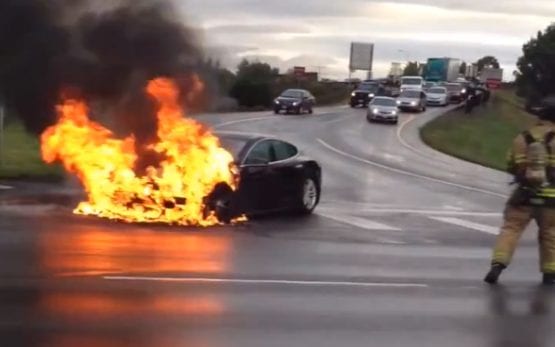Video of a Tesla Model S catching fire and burning near Seattle, Washington caused alarm after it was posted to auto site Jalopnik Wednesday. Outcry over the video contributed to a slide in stock price that began when stock analyst Baird downgraded Tesla to “neutral” on Tuesday. But fires are a regular occurrence in combustion-fueled cars. How much does this one crash mean?
 Highway fires in traditional combustion engine cars are not rare. A study by FEMA’s U.S. Fire Administration found “an estimated 194,000 highway vehicle fires occurred in the United States each year, resulting in an annual average of approximately 300 deaths, 1,250 injuries and $1.1 billion in property loss.”
Highway fires in traditional combustion engine cars are not rare. A study by FEMA’s U.S. Fire Administration found “an estimated 194,000 highway vehicle fires occurred in the United States each year, resulting in an annual average of approximately 300 deaths, 1,250 injuries and $1.1 billion in property loss.”
The Chevrolet Volt experienced battery fires in National Highway Traffic Safety Administration (NHTSA) testing two years ago, but the tests indicated no greater fire risk than gasoline engines.
Most — 85.8 percent — of fires occurred in passenger road vehicles, and only 7.1 percent were intentionally caused. A majority, 60.6 percent, originated in the engine area, and 22.3 percent were caused by electrical failure, a problem that fossil fuel-powered vehicles aren’t safe from. Electric cars, by contrast, are not powered by combustion — which is really just a chain of explosions under the hood.
According to Washington State police, the Model S struck some metal debris on Washington Route 167 near Seattle. The car warned the driver to pull over, and the fire didn’t begin until he had exited the car.
Highway vehicle fires are not especially fatal, with 2.3 fatalities per 1,000 fires, and that’s in part due to the firewall that separates the passenger from the engine. The Tesla Model S includes a firewall as well, and the blaze never spread to the passenger compartment.
This is all to say that an engine fire in an electric car is not especially remarkable, considering there are over 100,000 of them on the road.
Typically, NHTSA investigators would go to Washington to look into the Tesla crash, but with the government shutdown, that won’t happen.
Cleantechnia later reported that Tesla founder and CEO Elon Musk had issued a statement.
It said:
Earlier this week, a Model S traveling at highway speed struck a large metal object, causing significant damage to the vehicle. A curved section that fell off a semi-trailer was recovered from the roadway near where the accident occurred and, according to the road crew that was on the scene, appears to be the culprit. The geometry of the object caused a powerful lever action as it went under the car, punching upward and impaling the Model S with a peak force on the order of 25 tons. Only a force of this magnitude would be strong enough to punch a 3 inch diameter hole through the quarter inch armor plate protecting the base of the vehicle.
The Model S owner was nonetheless able to exit the highway as instructed by the onboard alert system, bring the car to a stop and depart the vehicle without injury. A fire caused by the impact began in the front battery module – the battery pack has a total of 16 modules – but was contained to the front section of the car by internal firewalls within the pack. Vents built into the battery pack directed the flames down towards the road and away from the vehicle.
When the fire department arrived, they observed standard procedure, which was to gain access to the source of the fire by puncturing holes in the top of the battery’s protective metal plate and applying water. For the Model S lithium-ion battery, it was correct to apply water (vs. dry chemical extinguisher), but not to puncture the metal firewall, as the newly created holes allowed the flames to then vent upwards into the front trunk section of the Model S. Nonetheless, a combination of water followed by dry chemical extinguisher quickly brought the fire to an end.
It is important to note that the fire in the battery was contained to a small section near the front by the internal firewalls built into the pack structure. At no point did fire enter the passenger compartment.
He said such an occurrence in a gasoline-powered vehicle might not turn out so well.
Had a conventional gasoline car encountered the same object on the highway, the result could have been far worse. A typical gasoline car only has a thin metal sheet protecting the underbody, leaving it vulnerable to destruction of the fuel supply lines or fuel tank, which causes a pool of gasoline to form and often burn the entire car to the ground. In contrast, the combustion energy of our battery pack is only about 10% of the energy contained in a gasoline tank and is divided into 16 modules with firewalls in between. As a consequence, the effective combustion potential is only about 1% that of the fuel in a comparable gasoline sedan.
For consumers concerned about fire risk, there should be absolutely zero doubt that it is safer to power a car with a battery than a large tank of highly flammable liquid.
This article was first published at Climate Progress. Reproduced with permission.










